|
|
Posted By Admin,
Monday, June 12, 2023
|
Jan Takes the Wheel
By Web Editor
January 28, 2016
Every time I go through Sara's garden I see new vistas with mind-boggling color and texture
Our posts have always had their inspiration in Sara's garden. The concept of 'form and foliage' comes from her particular gardening focus. Jan attempts to capture this concept and as she has become more familiar with both the garden and her craft, she has had more of a tendency to go rogue and resist direction. Thus, we bring you some of her favorite images, unrestrained by Sara's prejudices or guidance. Her comments follow:
Every photographer interprets light and color in their own way, and photographers develop a style or a 'way of seeing' that they present in their photographs. Sara wants the photographs to 'look real', i.e. the way SHE sees the scene. My reality is not always the same as hers.
Agave 'Blue Glow' beginning to flower
The phenomenon of 'digital darkroom' technology provides so many tempting opportunities to play with images and take them beyond what the eye sees. The Agave above is a good example, tuned up with Trey Ratcliffe's Aurora HDR (Macphun) and Adobe Lightroom software.
Senecio 'Staghorn', Pinus contorta 'Spaan's Dwarf', Spirea 'Goldmound', garden photography
I'm always fascinated by color repetition, which leads the viewer's eye through the scene.
One of the photographers who has inspired me is Dewitt Jones. He doesn't go out capturing images, he waits for the images to capture him. The above shot caught me due to the wonderful repetition of the steely blues in the Mexican pebbles, the succulent, the copper top of the lamp and the spruce in the distance, all complemented by the vivid red and green.
Cryptomeria japonica 'Elegans Compacta', garden photography
This is an exquisite plant with soft colors, enhanced by the bejeweling water droplets.
Close-up photography is challenging, because composing an image with the right "depth of field" (how sharp the image is throughout) is very challenging. In this case, I want to capture the delicate shape and coloration of the foliage while keeping it in the context of the overall characteristic of the plant: an explosion of clouds of needles in shades of burgundy, mauve and pink. I strive to have just enough background to give context without overpowering the delicate subject.
When I take close-ups of plants, I am aware of the life that exists in a garden
Our objective on this day was to photograph yellows and blues, both in landscape shots and close ups. I am always attracted to spider webs, because they demonstrate that the garden is teeming with life, much of it hidden. This ladder-like structure is particularly distinctive.
Cedrus atlantica 'Glauca Pendula', conifers, garden photography
I love the structure of the blue Atlas cedar, but it was the combination of colors and shapes on the ground that caught my eye
I concentrate on our focus, which is woody foliage plants, but I can't control how my eye is drawn to other aspects of the garden. Just as with the spider web, the garden is home to many other forms of life, which ebb and flow with the seasons. The cedar's bristly, blue needles interact with the fragile mushroom and the rusty leaves to create a completely different perspective. Dewitt Jones has always counseled 'the first image that you see may not be the one that is most distinctive. You need to move around and look at the subject from different perspectives, and maybe change your lens. In doing that, you may discover something more beautiful than you thought you saw originally.'
Brahea armata, garden photography
Sara wanted a photo of her favorite palm tree. She was startled when this is what I produced.
Sara expected a shot of the graceful blue-gray fronds that fan out over the succulent garden. When I went out to shoot the plant, I found myself fascinated with the yellow teeth along the stems and the fibrous trunk. I ignored the fronds and focused on what spoke to me. It took her a while to understand what I saw. This image now hangs in her home, because the plant took on an additional dimension for her once she understood my perspective.
garden photography, Brahea armata
The Mexican blue fan palm provides a fantastic opportunity for a classic graphic image.
I threw Sara a bone and focused on the leaves. Once again, I produced a different image than the one she expected. I was struck by the color and the steely structure. The pleats emanate from the stem dynamically, creating a sense of movement that I could not ignore. The imperfections make it more interesting.
Mangave 'Macho Mocha', succulents, foliage gardening, garden photography
I'm fascinated by this plant; it's an amazing combination of reptilian marking and metallic texture, complemented by beautiful colors
I'm really drawn to agaves because of their structure and their prehistoric aspects. This agave hybrid is particularly compelling, and I love the explosion of the lime green from the center to the mottled leaves. If you're any good at photography, you've learned early that you need to go beyond what first captured your attention and seek alternative views.
Mangave 'Macho Mocha', succulents, foliage gardening, garden photography
Complementary colors and contrasting textures make for a pleasing combination
The colors of the mangave are echoed in the colors of the restio, giving the image integrity and continuity. The image is strengthened by the contrast between the broad, strappy leaves of the mangave and the wispy, threadlike stems of the restio, capped with the burgundy seedheads.
Phormium 'Dusky Chief', garden photography
Sometimes I just can't help myself.
I recently got an 'infrared kit'. I love the way shooting in infrared reveals aspects of the image that conventional photography does not. If the palm shot nonplussed Sara, what do you think this one will do?
Stay tuned....
Tags:
Learn
Permalink
|
|
|
Posted By Admin,
Monday, June 12, 2023
|
The ACS gets a Shout-Out from the American Horticultural Society
By Web Editor
November 8, 2020
The conifer collection at The Oregon Garden. Photo by Janice LeCocq
The Oregon Garden's conifer collection has been one of the ACS's most successful Reference Gardens. ACS volunteers, led by Western Region member Doug Wilson, have worked in tandem with the Garden's staff and management to envision, plan, plant and care for a stunning variety of conifers and companion plants. The mounded beds in the conifer garden are replete with not just a dizzying number of conifer specimens, but also a wide variety of companion plants. Japanese maples, beeches, Japanese snowbell trees, peonies, ornamental grasses, dogwoods, heathers and heaths are only some of the plants used with conifers to produce painterly combinations of foliage that rival any floral display. The mix of evergreens and deciduous trees and shrubs, varied shapes, sizes and textures is amongst the best we've seen at any public garden.
The American Horticultural Society's latest monthly newsletter carries an article about The Oregon Garden, calling the conifer collection the Garden's 'crown jewel' and noting that there are 3,000 taxa in this one acre area!

We count over 30 taxa in this shot! Photo by Janice LeCocq
The pandemic has made travel challenging, but this is one to put on your list for when normal life resumes. The Oregon Garden Resort is on the property and guests are able to enter the garden at any hour. Wandering the paths of the conifer garden with glass of wine or cup of coffee in hand is a lovely way to experience this marvelous collection. And don't forget your camera!
The Oregon Garden
Tags:
Learn
Permalink
|
|
|
Posted By Admin,
Monday, June 12, 2023
|
The Sequel to the Ever-Popular Summer: Autumn!
By Web Editor
October 27, 2020
Summer is sedate, but Autumn is outrageous!
Fall Gardening
Back in July, as you may recall, our anonymous film director manqué wrote a piece likening his gardening to that of overseeing ensemble actors on a set, along with managing lighting, placement and interaction. Well, he's back with a sequel, and like so many sequels, this one is more dramatic than the original! While is it tempting to think that the garden director's job is easier than that performed on a Hollywood set, Hollywood generally doesn't have death, disease or pathogens impair progress, nor does it have the peculiar problem specific to garden design, wherein the subjects outgrow their spots. Imagine if a movie director had to get his project finished before the star player got (literally) too big for his britches. (Full cast, from left to right: Larix kaempferi 'Diana', Chamaecyparis pisifera 'Nana', Acer palmatum 'Ueno yatsubusa', and, to its right, Acer palmatum 'Pixie', with Pinus parviflora 'Ogon janome' in between. Behind is a blue form of Abies concolor, not a named cultivar but selected from the field. On the far right is Acer x 'Trompenburg', aka Acer palmatum 'Trompenburg'.)
In the photo above, the three maples, which were reasonably content to play as part of the ensemble, without claiming star billing, seem to have gotten Hollywood-sized egos as their autumn performance came around. The assorted conifers are all evergreens, and are steadfastly continuing on in character, while the maples apparently got fat new contracts and stars on their dressing rooms. What they don't appreciate is that the deep, rich, cool blues and greens allow the yellow and red to blaze. What is life - or beauty - without contrast?
Now the entire ensemble has autumn fever
Evergreens and Fall Color
In this shot we see that the director has changed the plot of the sequel to an inferno! Dogwoods, maples, grasses and more have all changed costumes to portray fall's fiery colors. Even the grass, stubbornly remaining green, gets an autumnal sprinkling. The evergreen conifers, again, reliably playing their parts, provide the contrast necessary to really ignite the deciduous characters. The blue spruce is particularly useful, as blue and orange are color-wheel opposites and opposite pairings produce the most dramatic combinations. The same is true of red and green. (Full cast, from left to right: Cornus florida 'Appalachian Spring' - note that the yellow behind it is Acer x 'White Tigress, which is a cross between A. davidii and A. tegmentosum, Abies procera 'Glauca Prostrata', Imperata cylindrica var. koenigii 'Red Baron', Ophiopogon planiscapus 'Kokuryu', Larix kaemferi 'Pendula, wrapped around Picea pungens 'St. Mary's Broom', Acer palmatum 'Pixie', Acer palmatum Ueno yatsubusa', Acer palmatum 'Koto no ito' (a very small specimen to the right of the lantern), Chamaecyparis pisifera 'Nana'. Two tall conifers in the background: Picea omorika 'Pendula' and the same blue Abies concolor. Far right in far background is Acer japonicum 'Vitifolium')
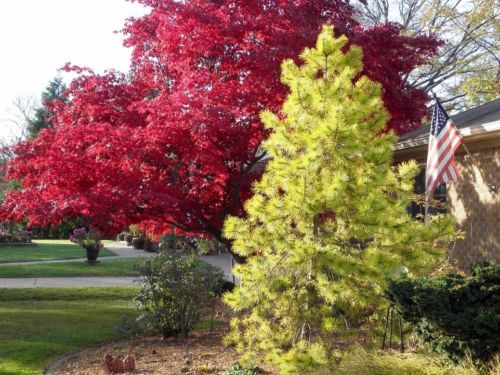 Finally, a conifer decides it wants to play with hot colors, too
Not all conifers are cool dudes in their blues and greens. Some, like the pine above, glow golden in autumn's soft light, and make a stunning pairing with a Japanese maple costumed in scarlet. We'd love to be able to call it a 'scarlet starlet' but this tree is mature and handsome; a diva, not an ingenue. Turns out that it was 'discovered talent', picked up at a clearance sale with no tag. With special coaching, our director teased its roots and gave it the confidence to play a leading role! The conifer is one that we have almost all coveted but have not all succeeded with: Pinus contorta var. latifolia 'Chief Joseph'. It lurks in the background for much of the year, playing an understated role of medium green. Come cold weather it reveals its true talents and struts its sunny yellow. This one may well be the largest specimen east of the MIssissippi, as it was planted over 25 years ago. Imagine whta it looks like when male cardinals cavort amongst its needled.
Did you think that this much color could be had without flowers? And neither one of these plants requires deadheading or fertilizing.
Japanese maple and conifer with a different supporting cast. Photo by Janice LeCocq
Our director gardens in the upper midwest, but lest you think that this only plays in Peoria, see the above shot of a garden in northern California. The stars (an Acer palmatum 'Ruby Lace' and a Chamaecyparis lawsoniana 'Barry's Silver') can take the show on the road and play with the local talent to round out the cast, in this case a couple of olive trees and some Helictotrichon sempervirens. Different cast, same powerful production.
The Oregon Garden welcomes autumn drama! Photo by Janice LeCocq
For much of the year at this Silverton conifer collection, the conifers' performance is center stage, playing majestically in full-needled glory. But autumn's colors make the conifers play off the season's stars, in this case a flaming heather. Once again, note how the blue of the conifer really sets off the hot tones. Not all actors can be divas in all productions! We need a chorus, too.
Can't grow Japanese maples? There are other ways to get seasonal color. Photo by Janice LeCocq
Ideas for Fall Garden Color
If you live in the mid-Atlantic, Southeast, lower midwest or Pacific Northwest, Japanese maples will play in your production very happily. Those in adjacent areas can also often find specific actors who will oblige. But if you find that Acer palmatum is a flop in your garden, there are many other plants that can provide autumn color to contrast with your conifers. The Aloe above is locked in a passionate embrace with a juniper, and come autumn, always blushes at the juniper's advances. If you are in a cold zone, try Rhus or Spirea, Fothergilla or Viburnum. For those of us in Mediterranean climates, we can often 'borrow' stars from other studios, successfully growing Nyssa, Viburnum, Cotinus and +other than palmatum. The mountain west has its aspens, and Texas and the southwest boast a long list of native species that color dramatically when the days shorten, such as oaks, maples, mesquite and cypress. Look at your garden as we approach the end of Daylight Savings Time. Could it use a little star power? Maybe even a star couple: a blue or green conifer and an orange or red deciduous co-star!
That's a wrap!
Tags:
Learn
Permalink
|
|
|
Posted By Admin,
Monday, June 12, 2023
|
Stylish Simplicity - Paul and Paula's Garden
By Web Editor
April 28, 2013
Because of our passion for plants, we tend to focus on gardens that feature collections of specimens and stretch our imaginations devising pleasing and provocative combinations of colors, textures and shapes. Sometimes, however, the strongest statements come from the deft use of massed plantings and fundamental color and design principles. Paul and Paula's garden is a beautiful example of keeping it simple without sacrificing interest or sophistication. And in best form and foliage fashion, this garden shines through the fall and winter months as well as spring and summer!

purple leaved plants, color wheel combinations, purple evergreen plants
Despite the unfettered design, much care went into its conception and the selection of the plantings. Paula, who has an artist's training and sensibilities, chose the Loropetalum to border the path because she wanted to echo the tones of the brick with a complementary plant that was appropriately sized and attractive year-round. The decision to use deep reddish-purple against the brick was daring; most of us think 'red' when we think of brick, but the purple brings out the rosy tones. Also, most of us would have not been able to resist the urge to plant a jumble of different colors and textures; Paula's confidence in the essential design principles of repetition, scale and color harmony allowed her to resist that temptation!
Chamaecyparis obtusa, purple-leaved foliage, succulents
The distinctive purple of the Loropetalums is repeated in the carpet of Sedum 'Voodoo' around the foundation plantings of Chamaecyparis obtusa cultivars. This is horticultural 'color blocking' with rich, deep tones, and the repetition of the purple and green makes for a unified design. While respecting the formal lines of the brick house, these plantings also soften, enrich and complement it.
conifers, foliage plants, evergreen plants
On the side of the house, Paula used more mass plantings of evergreen shrubbery and chose two Cedrus libani var. atlantica (Atlantic cedars) as focal points. Those of you that read our post on Color Scheming will recognize that the purple/brick combination represents an analogous color pair, while the blue/brick is a complementary combination. That's why the cedars are edgier and demand more attention, and their skirt of shrubs is correspondingly subdued. The brick borrows tones from the adjacent plants, appearing rosier next to the purple-leaved Loropetalum and more orange next to the blue cedar.
Arbutus 'Marina', Loropetalum 'Purple Pixie'
Note the crisp edging and the clean lines of the multi-trunked trees (an Acer palmatum cultivar on the left, Arbutus 'Marina on the right). The planted are sited to 'let the shapes show' and their structure is as important as their colors and textures. In this bed the Loropetalums function as punctuation and connect it to the walkway and foundation plantings.
purple foliage plants
The rich jewel tones are repeated throughout the garden, with different plant combinations. The Japanese maples and ferns adorn the wooded side yard that is shaded by towering Atlantic cedars and oaks. By varying the plant materials but sticking to the color scheme, the different areas of the garden are connected and unified. The overall sensation is one of serenity; the simplicity of the design is in itself relaxing and the choice of colors reinforces the calmness.
Japanese maples, gardening with rocks
We like to say that sometimes the best plant for a particular spot is a stone...and Paula repeats the blue of the cedars with specimen stones. The combination of purple, icy blue and rich green now has many textural components that continue to be unified by color and simplicity. The stones also echo the structural lines of the woody plants and provide interest throughout the year.
foliage garden, evergreen foliage
The latest project is a rock garden at the back of the property with newly planted roses, succulents and a few specimen conifers, anchored by a pair of mature Corylus avellana 'Contorta' (Harry Lauder's walking stick, one of which can be seen on the right side of the photo). Here purple gives way to accents of brilliant gold and chartreuse, and when the plantings spill over the rocks this will be the spot in the garden where the formality eases a bit, as it is away from the house and can set its own tone.
conifers, foliage plants, golden foliage
We look forward to visiting the garden again when the plantings around the rocks have matured and provided the cohesiveness that Paula intends. Although this spot is across the back lawn from the house, the brilliant Caucasian fir 'Golden Spreader' shines like a beacon and calls the eye. Another design principle that Paula has employed: light, bright colors project, dark colors recede. The strategic placement of one golden plant draws attention to the entire bed.
The final component of the garden design is a serene water feature
While Paula works with plant selection and design, Paul tends the Koi pond that not only provides pleasing sound and interest, but reflects the branches of the specimen trees. We came away from Paul and Paula's garden feeling relaxed and as if our blood pressure had dropped a notch. Isn't that a wonderful gift for a garden to bestow?
Tags:
Learn
Permalink
|
|
|
Posted By Admin,
Monday, June 12, 2023
|
Taxodium Update by David Creech
By Jeff Harvey
March 14, 2022
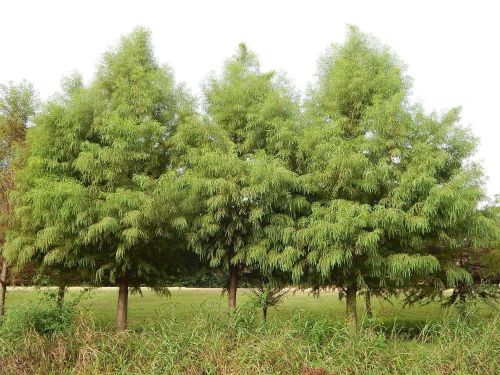
Taxodium Ianana t406
Taxodium at SFA Gardens – A 2022 Update
SFA Gardens remains a valued resource at Stephen F. Austin State University (SFA). This 128-acre garden in the Pineywoods of East Texas got its start in 1985 and includes a wide range of rarely encountered woody and herbaceous species. This is a collector’s garden, and one of our most intense collections is Taxodium.
The precise nomenclature for Taxodium remains a matter of some debate. Still considered by many as three species (T. distichum, T. ascendens, and T. mucronatum), we believe there’s enough consensus in recent literature to list Taxodium distichum as a single species with three botanical varieties (Arnold et.al. 2007 and Adams et.al. 2012).
Taxodium distichum (L.) Rich.var. distichum (Baldcypress - BC)
Taxodium distichum var. imbricarium (Nutt.) Croom (Pondcypress - PC)
Taxodium distichum var. mexicanum (Carriere Gordon) (Montezuma cypress - MC)
Our history with Taxodium includes connecting with the Taxodium Breeding and Improvement Program at the Nanjing Botanical Garden in the late 1990s (Creech et.al. 2011). I have been making the trek to China once or twice a year since 1997. Of course, that is until Covid descended on our life in March of 2020. In the last twenty plus years I have become close friends with the leader of that program, Professor Yin Yunlong, and his hard-working staff. They have visited SFA many times and we’ve enjoyed graduate students and exchange scientists from his program, as well as Nanjing Forestry University. I consider them the world’s primary research team on this fascinating and ancient genus. In China, Yin Yunlong has observed that MC hybrids show super-parent advantage in height, trunk diameter, biomass increase and no knees. That last trait is very important. One of the great negatives associated with bald cypress is the development of knees (pneumatophores). BC typically produces knees. MC and the hybrids with MC do not. With great potential in timber, energy, carbon sinks, and water conservation forests, MC hybrids are widely used for urban and rural greening, shelterbelts for farmland, and forests for coastal areas in southeastern China. The scale of Taxodium use in China needs to be seen to be appreciated but it is in the millions of trees planted and that continues to this day. The “greening” of China is real and our native bald cypress is part of that mix.
Chinese scientists believe that controlled Taxodium hybridization can combine the best characteristics of superior parents and allow for selection of superior clones. My friend Yin Yunlong once said, “everyone agrees that superior parents produce superior children.” Selection criteria in the Nanjing Botanical Garden for controlled cross and open pollinated seed crops includes growth rate, salinity and alkalinity tolerance, flooding tolerance, needle blight resistance, form/shape, fall color and ease of cutting propagation. In this paper, the term “hybrids” refers to the progeny of crosses between botanical varieties of Taxodium distichum. In several studies in China and here at SFA, the hybrids demonstrated improvements in growth rate, salt and alkalinity tolerance, form and vigor. We have provided trees for some very high pH test sites in central Texas and have a large collection of hybrids planted in our plots at Moody Gardens on Galveston Island in a high salt environment. They get an A for salt and alkalinity tolerance.
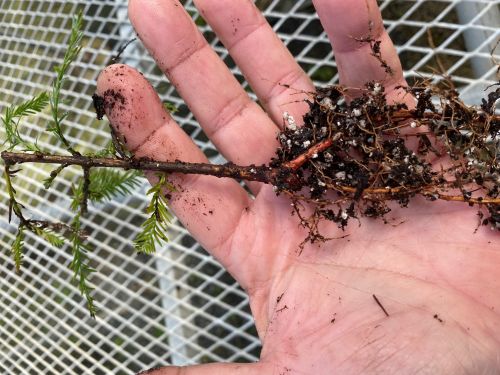
T406 Cutting
The breeding program in China can be summarized as controlled cross and open pollinated seedlings grown out in large fields at close spacing (about 6” to 1’ apart in rows 4’ apart is typical).
After the first year, they are then cut off near the ground. That last step results in upright shoots and the strongest leader is favored. They usually grow 4-5 feet in the second year and selections are made then. The selections are propagated by cuttings, rooted, planted out and then allowed to grow to provide a foundation for cutting generation. Four to six-inch cuttings in June with an overnight hormone dip is a typical strategy in China. Young seedlings provide wood that typically root quite well. Cutting wood from old trees root poorly or not at all. One strategy is to cut the trees back severely all the way to the trunk which generates plenty of vigorous growth. Thick, robust green cuttings root better than thin twiggy wood. From my experience, the key to success depends more on the actual age of the clone and the nature of the cutting wood than hormones. Because they are cutting grown, the resultant plants typically exhibit plagiotropic growth (growing more or less divergent from the vertical, also referred to as topophysis. That is they tend to be “branch-like” and don’t form a leader unless pruned and trained. Upright growing shoots, however, begat upright growing trees.
Out of a about a dozen advanced selections from China, one BC X MC clone has emerged that is superior simply because it is quite free of needle blight, Cercosporidium sequoia. It was tested as T406 and with Nanjing Botanical Garden’s permission, we named it ‘LaNana” after the creek that traverses this university (Creech 2017). In our region of Texas and all the way across the Gulf South, Montezuma cypress can be affected by needle blight (McDonald et.al. 2008). ‘LaNana’ has proven to be highly resistant in our cooperator plots while other selections can be quite dramatically impacted, some years worse than others. For instance, we have another clone (T502, named ‘Banita’) which is almost evergreen in most winters, keeping old needles until the new growth emerges in March, the degree of needle drop depending on the severity of hard freezes. The term for foliage retention long into the winter is marcescent. ‘Banita’ is very fast growing and features light green foliage but lacks resistance to needle blight in some of our test locations in the humid Gulf South. However, in central Texas and parts west, it appears free of the malady.
One final question has been answered. After winter storm Uri in mid-February 2021, we can report that all of our Taxodium collection came through without any damage. With an all-time record low of -3oF in Nacogdoches, we now have a benchmark for hardiness. Since none of the hybrids have ever experienced such a low temperature, this was a great test and we now have the promise of a more northern range limit. The December 1983 and 1989 freezes and the February 2021 freeze provided hard evidence that even straight MC is surprisingly hardy.
If you are interested in trialing the hybrid bald cypress, we suggest you make a trip to the Pineywoods of Texas. We’ll give you a fine windshield tour of the collection and if we have them on hand in small sizes, we do love to share. Let’s keep planting.
Red River Wildlife Refuge
LITERATURE CITED
Robert Adams, Mike Arnold, Andrew King, Geoffrey Denny, David Creech. 2012. Taxodium (Cupressaceae): One, Two or Three Species? Evidence from DNA Sequences and Terpenoids. Phytologia 94 (2): 159 – 168.
Arnold, M. and G. Denny. 2007. Taxonomy and Nomenclature of Baldcypress, Pondcypress, and Montezuma Cypress: One, Two, or Three Species? HortTechnology 17 (1): 125-127.
David Creech. 2017. Taxodium X ‘LaNana’ – Born in America and Mexico, Improved in China.
Tags:
Learn
Permalink
|
|
|
Posted By Admin,
Friday, June 9, 2023
|
The Miracle Mile, Part 2
By Leah Alcyon
November 2, 2020
Two Juniperus occidentalis (Western juniper) are visible behind the author
In October of 2016, I backpacked with my husband into Little Duck Lake in Northern California and spent three days “ticking” 17 species of conifers that grow in a richly diverse square mile of high granite mountain terrain. I wrote about that experience in the ConiferQuarterly with an outline of the history of the “miracle mile” and the process of finding all of the species in that area. One extra species was known at that time, and although the coordinates were not available, we made an attempt to find it anyway. The area in question is steep slab granite that is accessed from a valley where thick brush makes climbing difficult. We hiked up the trail to Sugar Lake and poked around for an afternoon on and near the slab granite but we did not have the right stuff for success.
Fast forward a few years and we now have a new formula for success. First, Calypso our 10 year old Shar-pei/Shepard joined in the adventure as she is a hiker and conifer connoisseur. Looking for one Juniperus occidentalis among the myriad Douglas squirrels and chipmunks was right up her alley. After the fires and smoke in the area finally cleare, it seemed an auspicious time for some late season hiking. The real key for success, however, was Michael Kauffmann’s update to the website for his book, Conifer Country, which now included the latitude and longitude of the western juniper! Not that we aren’t intrepid hikers fond of cross country bushwhacking, but there is a psychological energy necessary to scour the mountains off-trail for trees rather than stroll on a trail to a known site. Richard Moore, a local from Callahan, had been hiking in the area since the 1980’s and knew about the pocket of western junipers on the Sugar Creek drainage. He connected with Kauffmann after Conifer Country was published. It is one thing to be an intrepid hiker, but quite another to know an area like the back of your hand and be able to identify plants and trees that might be unusual. A good analogy is bird watching, where it’s great fun to get a report of a rare bird and go chase it, but quite another matter to be the one to spot it in the first place.
So although we were not going to be the discoverer of the junipers in this area, it was challenging enough to scramble through the brush and climb the steep granite cliffs in search of this elusive tree. Western juniper usually occurs on dry, rocky sites where there is less competition from larger species and, true to form, this is where we found them. There must be 20 individuals along fault lines going upwards from 6000 ft elevation to the ridge at 7000 feet. Each tree had a different look; some were straight and some were buckled and krummolzed. The one that was lowest down was in the shade of a pine and very small. Finally, even though we needed the GPS coordinates, it was exhilarating to make it to the wall and see numerous juniper trees, lined up with the gravity fall of their berries down seams in the granite.
And the berries on the junipers are so numerous this year that there were a number of trees that looked like grape vines, they were so laden with purple fruit.

No, we're not making wine, we're making gin!
Townsend’s solitaires, Clark’s nutcrackers, and varied thrush were in abundance around the trees. The biggest surprise was a frog – sitting on the granite at 6,000 feet! It appears to be a Cascade frog, Rana cascadae.
Rana cascadae, basking in the sun at high altitude
After taking photos of the different shaped trees and the masses of berries, we headed back to the main trail. Calypso, with her four-paw drive, had easily accompanied us up the trail and up onto the granite. But it was clear that going down was not as easy as going up, even for her.
As for the evolution of the miracle square mile, we noted that the boundaries have been shifted slightly from the first iteration to a new area, which now includes the western juniper above Sugar Creek. Sugar Creek and the lake are also highly diverse conifer environments and very accessible. While chilling out in the one and only camp site at Sugar Lake, I was able to quickly find seven species of conifers. Several more were within a short distance of this area. On the hike out we scanned the granite wall for the junipers with binoculars and found them clinging to the vertical wall for dear life!
Nature made some beautiful sculptures in the Miracle Mile
A list of conifers within the Miracle Mile:
Tags:
Learn
Permalink
|
|
|
Posted By Admin,
Friday, June 9, 2023
|
By Web Editor
May 10, 2020
Learn about conifer cultivars, or cultivated varieties, and how to make new plants from old ones.

Photograph by Rowe Arboretum
Although not realized at the time, the development of new cultivars of arborvitae, the hobby of one of the authors, took a giant step forward when it was noted in Chub Harper’s yard that a Thuja occidentalis ‘Filiformis’ was producing seed. For 20 years, the senior author had been planting seeds from Thuja occidentalis cultivars (23 different ones) in an effort to develop something new.
The effort met with success on three occasions, an average of one new cultivar every seven years. Perhaps because Chub realized that new cultivars come more readily from witch’s broom seed (one of Chub’s well known specialties) than from Thuja seed, he gave me carte blanche to pick all I wanted. The yield was not very interesting; half the seedlings had ‘Filiformis’ foliage and half normal foliage.
For a reason which is now not clear, all were discarded or given away except for one with normal foliage which was planted in the yard. It grew into the large non-descript plant shown and out of curiosity some of its seeds were planted.
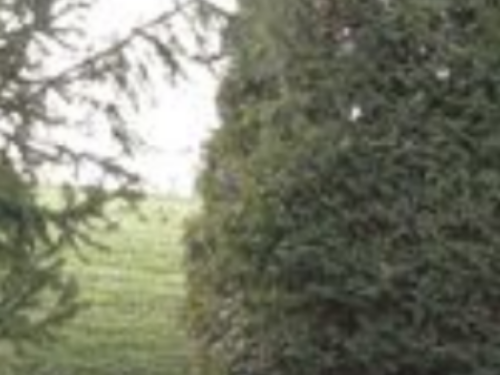
This “generic” Thuja occidentalis was grown from a seed from ‘Filiformis’. It is unique in that its seeds produced a wide variety of Thuja occidentalis cultivars
Variable Cultivars from Parent Thuja occidentalis
The result was surprising. The seedlings were a bonanza of unique plants, some with foliage which was most typical of Thuja and others with the threadlike foliage of ‘Filiformis’. Of those with foliage resembling Thuja, some were globular, others columnar and a few pyramidal. The amazing part was that they were all progeny of a single, ordinary looking arborvitae.
The uniqueness of such an event is brought home by Humphrey Welch’s statement in his Manual of Dwarf Conifers to the effect that the probability of raising a new dwarf from a packet of conifer seeds is in the order of millions to one against.
To the contrary, we had many from a few seeds. Their variability is too great to be described in a few pages. Thus, we have limited the presentation to only a few, particularly those which are older and more mature.
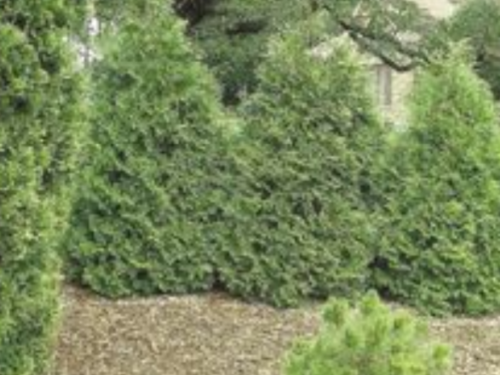
One of several stands of Thuja occidentalis ‘Filiformis’
Cultivars with ‘Filiformis’ or ‘Filiformis’-like Foliage
Three plants are described as noted above, all came from seed from the mundane tree. Thuja occidentalis ‘Pincushion’ is characterized by whip-like foliage so abundant that it is not possible to see the approximately one inch long trunk. Some of the foliage strands have a very short branch at the end.
It is green in color, but interspersed are a few brown filaments making its name appropirate; the less abundant brown filaments can be considered pins stuck in the abundant green foliage, visualized as the cushion.
The original plant, now seven years old, is 27 inches across and 32 inches tall. Rooted cuttings also have foliage making the trunk invisible. A number of young seedlings have foliage similar to ‘Pincushion’, but differ in that they have easily visible 4- or 5-inch trunks.
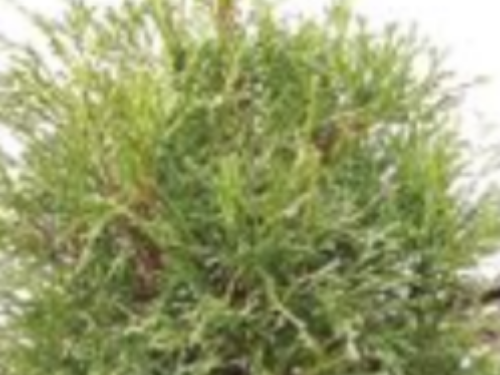
Thuja occidentalis ‘Pincushion’. Original plant. The trunk is extremely short
‘Pincushion’, 'Little Filley', and ‘Fuzz Ball’ Conifer Cultivars
The foliage on Thuja occidentalis 'Little Filley' is unique compared to that on ‘Pincushion’. Only an occasional thread-like strand may be seen. Instead, there are many branches coming off at multiple angles, making the plant very irregular.
The branches and branchlets are all of approximately the same diameter and, since they seem to be the only structures containing chlorophyll, one might expect that the growth of the plant would be slow. So far, at age eight years, it is 15 inches tall and 10 inches wide.
Another unique plant is Thuja occidentalis ‘Fuzz Ball’. From a 4-inch single trunk arise several branches (not visible in the photo) which ascend in close apposition for a short distance and then end in threads of ‘Filiformis’ foliage. The foliage is abundant, largely unbranched, and merges to form a very symmetrical single ball.
If the ball should become very large, it could be a valuable accent plant. Its ultimate size can, of course, not be predicted. The plant pictured is 4 years old and 12 inches tall. One cannot judge the chlorophyll content of this plant from the picture since it was taken in the winter when all plants in this category have foliage which is brown and in some cases almost black. The variability of these plants starts when they are about two years old as demonstrated by the two of this age

Thuja occidentalis ‘Little Filley’. Original plant is 7 years old
Cultivars with Foliage More or Less Typical of Thuja
Although the plants with foliage closely resembling typical Thuja were, with some exceptions, not as unique and attractive as those in the other group, they nevertheless came in a number of shapes and sizes. Some were columnar, some globular and some roughly pyramidal.
The foliage on many of these was loose and, in the overall, they were not of the quality of many well-known Thuja. As a consequence, they have not been named or propagated. An example of loose and open structure is seen in the three very similar, roughly pyramidal plants. They seem disinclined to grow tall and might be suitable as a low hedge.
The typical Thuja foliage of two in this group was gold in color and not unlike that of other yellow cultivars. One of these had an occasional ‘Filiformis’ branch. Their poor structure made them inferior to other yellows and, thus, they have not been named or propagated.
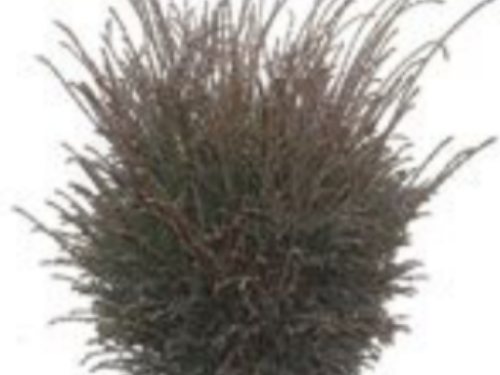
Thuja occidentalis ‘Fuzz Ball’. Original plant of an unusual dwarf
Plants which were virtually identical, but coming from different seed, as was the case with the plants illustrated above, were not unusual. The form which was most often replicated was globular or slightly oval and had finely-cut foliage which vaguely resemble that of Thuja because the foliage was of limited length.
The outline of the plant was more smooth than that of the usual globular plant. Because of these characteristics, the first plant was named Thuja occidentalis 'De Luxe'. The numerous subsequent forms had for added interest typical broad Thuja foliage embedded in the finely-cut foliage. These plants still had a smooth outline and from a distance appeared the same as others. They have not been specifically named. As with many globes, these plants when old and large tend to fall apart with a snow
load.
We are attempting to determine whether any of the many seedlings of this type will be resistant to this kind of damage. So far, those which opened up in the winter closed in the spring. As above we have in a rather cavalier fashion separated these plants into two groups based on their foliage, occasional plants such as that here show characteristics of both groups making them impossible to classify.
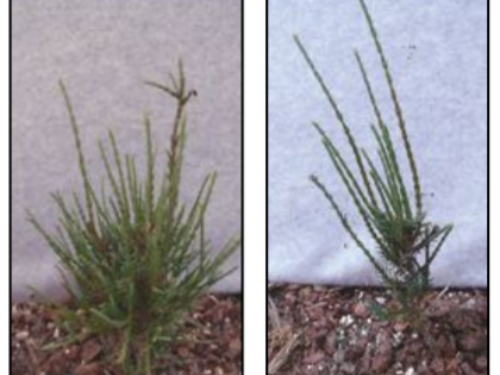
Two year old seedlings showing variability at an early age
Practical Considerations with Conifer Cultivars
A disadvantage of attempting to duplicate this method of developing new cultivars is the time involved. Thuja occidentalis ‘Filiformis’ rarely produces seeds. Of two approaching 25 years of age, with which the authors are acquainted, one has produced seed once. Once the seed is procured, there is another long wait for the seedlings to produce seed.
This stage might be hastened by the use of plant growth regulators or by girdling or otherwise injuring the tree. Once the seedling (which would be of the generation of the plant) has itself produced seed, there is another wait before the nature of the final product can be determined. This is, of course, when the fun begins.
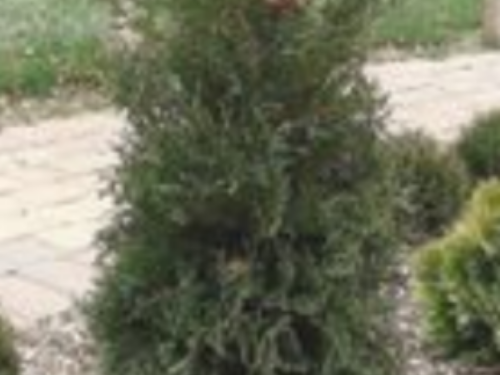
An unusual columnar plant of this progeny. The foliage is open and loose
Cultivars: A Result of Genetic Chaos in Conifers?
The variability of these plants appears to be the result of some genetic chaos occurring at the time of pollination. This deviation from normal events appears to affect not only the morphology of the plant arising from the embryo, but also the metabolic processes involved in germination and embryonic growth. The latter disruption is probably responsible for a germination rate for these seeds rarely exceeding 30%, a rate much less than that for most cultivars
Of great practical interest about plants from this progeny is that they seem resistant to burning of the foliage by the sun. Whereas we experienced days, in which the temperature hovered about 100 degrees F and Thuja of other progeny were either partially or completely burned, full sun did not cause burning on plants from this progeny, whether the foliage could be classed as Thuja-like or ‘Filiformis’.
For those who may be interested in seeing more of the variability of arborvitae grown from the seed of this plant, 34 different, relatively mature plants are on exhibit at the Stanley M. Rowe Arboretum, 4600 Muchmore Road, Cincinnati, Ohio 45243.
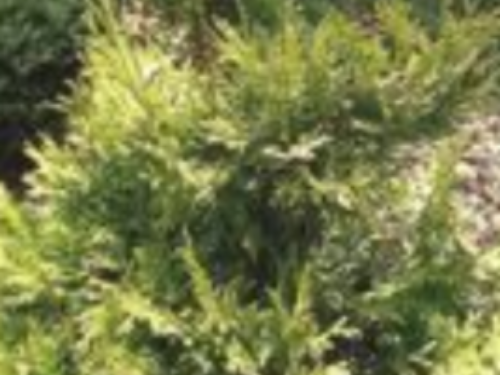
These open and loose pyramidal plants came from di!erent seeds from the generic Thuja occidentalis above
Text and photographs by Clark D. West and Christopher Daeger.
This post has not been tagged.
Permalink
|
|
|
Posted By Admin,
Friday, June 9, 2023
|
By Larry Nau
March 20, 2015
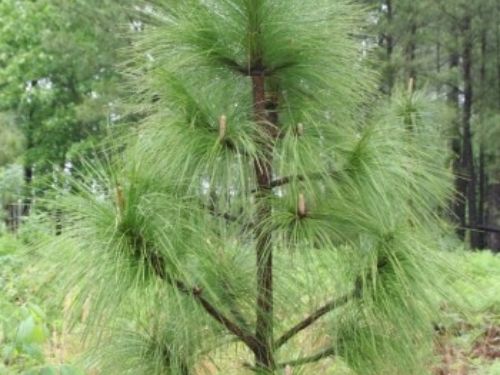
The longleaf pine, Pinus palustris, once dominated the landscape from Virginia to east Texas, covering an estimated area of over 90 million acres. With the arrival of the British explorers in 1607 and their subsequent exploitation and destruction of the longleaf pine forests, this tree virtually disappeared in many areas. In cultivation, Pinus palustris has no registered cultivars and is, therefore, seldom grown by ACS members. However, the tree has many desirable attributes, particularly in the “grass stage”. The species features 8” to 20” needles, with 6” to 10” cones. The tree itself grows to a height of 130’. Longleaf pine is an imperiled species, and the American Conifer Society has made its first contribution toward the re-establishment of this historic and important conifer.
When John Smith and other British explorers arrived in 1607, they were searching for gold and silver in Virginia. They did not find gold, but they did find another valuable resource, the longleaf pine. From the longleaf pine came naval store products such as pitch, tar and turpentine which were then sent to England. Since England was quickly becoming the dominant naval power of that era, and naval stores were vital to maintaining wooden ships, these products were critically important to their growing fleet.
Soon the naval store industry was exerting a huge toll on the longleaf pine forests through destructive pine resin harvest. This timber was also highly prized in the booming ship building industry and for construction by the colonists pouring into the American Southeast. The forests were eliminated so that agricultural crops could be planted to support the growing human population. Forest regeneration was stifled by the presence of feral hogs which fed on the roots of the longleaf seedlings. Next, the trees were subject to widespread harvest during the era of steam train logging, as the longleaf pine has exceptional straightness and strength in its timber. Lastly, fire was suppressed, which is a critical component of the longleaf pines growth and development.
In Virginia alone, it’s estimated that by 1850 more than one million acres of longleaf pine forest had disappeared. Today, scientists have counted fewer than 2000 native Pinus palustris remaining in the natural forests of Virginia. Pinus palustris has been almost eliminated from its northern most range in the USA.
Longleaf pine forests are an important component of the ecology of the American Southeast. Longleaf pine is a keystone species and mediates fire effects which provide habitat for a wide variety of plant and animal species including Bobwhite quail, red-cockaded woodpeckers, and Bachman’s sparrows. Since the forests often contain wet seepage bogs and flatwoods, Mabee’s salamanders, pitcher plants and sundews can be found. Species of orchids, lilies, wildflowers and sedges also proliferate. Longleaf pine can live for more than 300 years. As a result, they may be most helpful for long-term carbon sequestration. The utilization of carbon is not only good for the Southeast, but our entire planet.
There are many efforts directed toward the restoration of the Pinus palustris. The federal government, numerous environmental groups and even private landowners have partnered to replant the longleaf pine. One such effort is located at the northern range of longleaf pine in Sussex County, Virginia at the 232 acre Joseph Pines Preserve (JPP). Inside the Joseph Pines Preserve, over 60 acres of land have been restored with over 10,000 native Virginia, longleaf pine trees. The seed was collected from the last native longleaf pine trees in Virginia by biologists from Meadowview Biological Research Station and the seedlings were raised at their nursery in Woodford, Virginia. In addition, the goal of Joseph Pines Preserve is to restore the biodiversity of the indigenous longleaf pine – pitcher plant ecosystem (see prospectus on the Joseph Pines link at www.pitcherplant.org).. The preserve is also dedicated to capturing the entire Virginia longleaf pine (Pinus palustris) genome by grafting, fascicle rooting, or seed propagation. Joseph Pines Preserve has recently purchased an adjoining property to create The Center for Biodiversity. This facility will serve as an education and training center for longleaf pine/pitcher plant ecosystem restoration and a nursery will support conservation and restoration efforts.
At the 2014 ACS Board of Director’s Meeting in Atlanta, the Board approved a donation of $1,000 to Joseph Pine Preserve from the ACS Endowment Fund. These funds will assist JPP’s efforts to propagate, replant and preserve the native Virginia longleaf pine. This donation marks the first time the ACS has actively supported an effort to conserve conifers in the wild. Thank you to the Board as the ACS fulfills another important aspect of its mission.
I am working with Dr. Phil Sheridan of Meadowview Biological Research Station to offer another opportunity for the ACS members to personally assist with the restoration of the Virginia longleaf pine at Joseph Pines Preserve. This spring, JPP will be planting another 1,000 Pinus palustris, and you can help to plant these young trees. It is impossible to predict when the ground will be suitable for planting. Therefore, look for updates on the ACS website starting any day. Interested ACS members can also contact me directly by email at [email protected] or cell 585-202-1815. We hope to not only plant these 1,000 trees, but also have some time to learn about this unique and fragile ecosystem. Join us in restoring the Virginia longleaf pine to its northernmost habitat.
http://youtu.be/LZGJJzdRHHA
This post has not been tagged.
Permalink
|
|
|
Posted By Admin,
Friday, June 9, 2023
|
Fairy Gardens, with Conifers!
By Web Editor
March 8, 2021

Fairy garden in a wagon.
Text Elden Wheaton
Photography Ron Elardo
With little fanfare, a new form of gardening has been rapidly gaining ground. Extensive displays of miniature figurines, furniture, and tiny plants, all sold at nurseries, are the telltale elements found in what are known as fairy gardens. They are popping
up mostly as indoor gardens and containers, set outside during warm weather in garden beds, or simply maintained in homes and on porches. They meet the need for wanting a garden without having the space or time for a large one. Then there’s the whole
cuteness of creating and playing in your own tiny, secret garden, decorated with things like furnishings and accouterments of dollhouses.
At our local nursery in Adrian, MI, the phenomenon has added new kinds of plants, too, many of which are conifers. I have been creating small garden bowls with little conifer forests in them for quite some time. Lately, little conifers have started catching
on at our fairy garden classes. Enthusiasts have added conifers among their tchotchkes, /choch-kees/ (Yiddish for a small object, a trinket). The result is a personal expression of one’s imagination, like a bridge to a castle nestled in the woods,
or a witch’s hut secluded in the shadow of trees, waiting for Hänsel and Gretel.
The tchotchkes represent anything you can think of; the sky’s the limit. Figurines include gnomes, fairies, animals, and seasonal characters like Santa Claus. A Halloween scene might include scary ghouls and goblins. You can find them all, either online
or at your local nursery. Check out the Internet, too. You’ll be surprised what you’ll find when you Google “fairy gardens”. DYI fairy garden ideas will pop up. Stores selling tchotchkes are relatively easy to find. North of Adrian, in Brighton, MI,
there is a Fairy Garden Super Store. Suppliers will ship supplies free with certain orders. Also, magazines run how-to articles on fairy gardens. It’s dizzying.

Editor’s Halloween fairy garden with Platycladus orientalis ‘Franky Boy’ (Franky Boy Chinese arborvitae)
and Chamaecyparis pisifera ‘Blue Moon’ (Blue Moon sawara false-cypress).
Fairy gardens are very easy to create and manage. So, let’s start with some basic elements:
- You will need a container, something colorful with an interesting shape, but not too deep, to house the garden.
- The soil medium needs to be the kind that holds moisture and allows for good drainage.
- For the planting medium, mix peat, sand, fine basic compost, topsoil in equal amounts, and a handful of horticultural-grade charcoal pieces for improved drainage and moisture retention.
- Save the medium mixture in an airtight container for future gardens.

Chamaecyparis obtusa ‘Fernspray Gold’ (Fernspray Gold Hinoki cypress) in a small fairy garden.
Now for the conifers.
Any small conifers will work. These will be “baby” conifers that, when planted in the garden, can reach mature heights of 35 feet or taller. One of your jobs with these conifers will be to keep them small. Over time, you will find that the little trees
will look mature even though they are kept tiny. Trunks and branches will thicken and give your plants a look of being old. You may even find your trees resembling bonsai. There is ample online information on pruning and keeping miniature trees little,
including the tools to do it. I prefer using spruces like Picea mariana ‘Blue Planet’ (Blue Planet black spruce), Picea glauca var. albertiana ‘Elf’ (Elf dwarf Alberta spruce), ‘Pixie’ (Pixie dwarf Alberta spruce), and ‘Pixie Dust’ (Pixie
Dust Alberta spruce), but any conifer genera will do. Just start with small specimens, no more than six inches tall. Next, the plants have to be prepped for planting in a semi-shallow container of no more than 12 inches deep.
It’s best to clean the rootballs of their original planting soil. Snip the root tips just a little bit, so that they will be stimulated to grow and grip the new planting medium. That way the roots will begin to spread out and multiply. Gently dig a small
place for each plant. Once installed, gently press down the soil around the conifer. Next, use a small cooking baster or eyedropper to water the plants. Like all containerized plants, your new garden should never be allowed to dry out, at least not
during the growing seasons (spring, summer, and fall). Use a water probe to know when to water.
During the growing seasons, the fairy garden will need fertilizer. Osmocote 15-9-7 is the best formula. I mix a teaspoon full of fertilizer with water in a bowl for easy application. Just remember that less is better. Too many plant parents think they
need to overfeed their babies. Also, pay attention to sun requirements that will depend on the numbers and kinds of plants you install. Most conifers like full sun. However, remember that plants in small containers need to be protected from the sun’s
hot, direct rays. Some fairy garden practitioners place their miniature gardens here and there under trees and other plantings in the garden to create surprises.
In Winter, your fairy garden will require more moderate light and minimal watering. If the rootballs freeze, stop watering until spring comes, and the rootballs thaw. Garages with windows are good places to overwinter your conifer fairy garden(s). Attached,
unheated garages rarely reach freezing temperatures. Three-season porches are good storage places, too. I say “gardens” because, once you do one, you will want to do more. At a recent fairy garden workshop, one participant created her 24th fairy garden
to join all those already housed throughout her home! She was not alone in having a collection of fairy gardens. One definitely leads to several.

Assorted conifers and completed fairy gardens.
Other living elements can be added to complement the conifers. Natural moss can be the lawn. Varieties of small hostas, sedum, and other ground cover perennials can also simulate a lawn. Hillside effects are fun to create, in order to enhance further
a three-dimensional landscape. Small-sized gravel and wood chips can duplicate pathways, while stones can mimic rocks and outcroppings, even mountains. Once you have decided on the physical landscape, it’s time to add things like wells, houses, fences,
figurines, or whatever else you can find. Even ponds can be simulated with pieces of blue or green plastic.
Fairy gardens are not just for older gardeners. Parents and grandparents have shared the fun with children, who, in turn, exhibit a genuine love for tiny gardening. Children take to it easily and reveal their own flair for the fantastical. In Adrian,
containerized conifer classes have been held for children at our city library, private homes, and nursery schools. Children regularly accompany family members to fairy garden classes at our nursery. They like building and tending their own gardens.

ACS members will be gratified to know that conifers have now become part of this activity. Who knows? Maybe the youngsters creating fairy gardens today might be planting full-sized conifers in their gardens tomorrow and might even be joining the American
Conifer Society. Whatever the age, fairy gardens are showing up all over. They’re fun to create and they bring joy to their owners.
Elden Wheaton is nursery manager at Barrett’s Nursery and Landscaping in Adrian, MI. He is a certified landscape designer, educated at Michigan State University.
This post has not been tagged.
Permalink
|
|
|
Posted By Kelleen Trauger,
Friday, June 9, 2023
|
Looking for the Perfect Bonsai
By Jack Christiansen
August 23, 2019
Getting started with your bonsai hobby is as easy as heading outdoors.

Pinus ponderosa
(Ponderosa pine), styled as a semi-cascade bonsai for 12 years
by Carl
Morimoto who purchased the plant at a regular nursery in California
The Conifer Bonsai Hunt Begins
Spring
is here, and I cannot think of a better time to go on the hunt for
plants, either to start as bonsai, or to add to an existing collection
of bonsai. Nurseries have already begun receiving new inventory for the
season. The warmth of the sun beckons us to get out of the house and to
be the first in line to view the new stock. Spring can also send us in
other directions, in order to investigate sources of future bonsai. You
might be surprised to discover, just where new finds exist.

Juniperus
californica (California juniper), styled as an informal upright bonsai
for 17 years
by Seji Shiba who collected the plant in the Mojave Desert,
California
Many
of my friends have scored specimens by digging up small trees or
shrubs. Some plants have been growing in their own backyards. Many
times, future bonsai have come from jaunts through the woods. Neighbors
in my community have decided to remove plants from their own gardens and
have even been willing to dig plants for me. It is exciting to explore
the possibilities!

Taxodium
distichum (bald cypress), styled as a formal upright bonsai for 21
years by George Shoptaw who collected the plant in Louisiana
An
older plant can have a special potential and may reveal interesting
trunk shape and branching, well before bonsai-ing. On walks in my
community, I have noticed plants I have wanted to acquire. I have gone
so far as to ask politely if I might remove a plant in exchange for a
new plant of the same size.
Bartering
for plants and services rendered can result in a nice payoff. For
example, old hedges of Taxus (yew) are a great source of bonsai. The
plant hunter might have to go far afield to catch sight of a specimen
which is worthy of transformation into a bonsai.

Callitris oblonga (Tasmanian cypress pine), styled as a literati bonsai for 10
years by John Thompson who purchased the plant at a bonsai nursery in
California
Scouting for Conifer Location
Mountain
areas and forests can yield great specimens. The San Francisco Bay
Area, where I live, offers a wide diversity of regions, which are home
to many species of conifers. Plants native to the Mediterranean climate
grow here and add a new dimension for beginners and also experienced
collectors. Always check your USDA zone to find what plants will thrive
in your area!
When
digging conifers in the wild, the land owner, be it a governmental unit
or a private individual, generally requires permission to enter an area
and remove plants. Conifers taken from the wild need special aftercare.
Mortality
rates can be high. I would not recommend digging a plant, especially if
there is no way to ensure a sufficient root ball. A quick Google search
will provide sources on trunk caliper versus minimal root ball
diameter.
Many
of these naturally-occurring trees may live in small cracks or
crevices. The weather in these conditions often creates an extreme
environment, in which plants may only grow 1 inch or less each year.
These plants make for highly desirable, collectible bonsai.

Juniperus chinensis ‘Shimpaku kishu’ (Chinese juniper), styled as a slanting
bonsai for 12 years
by the Bonsai Society of San Francisco. The plant
had been collected from a garden in California
Club
members whom I know have developed their trees over years. They have
shown their creations at yearly meetings. The bonsai are wonderful
examples of natural art and are often hundreds of years old. It takes a
high degree of skill to reveal that hidden beauty. A number of bonsai
collectors in different parts of the United States go out and gather
plants annually. They sell them, in turn, to other bonsai enthusiasts,
or to well-known bonsai nurseries. You can Google “bonsai nurseries” to
find the locations of such sources near you.
Other
sources, of both developed and potential trees, are bonsai club
meetings. Anyone can attend these gatherings. Clubs have annual
fundraisers, where members bring in and offer specimens for sale at a
good price, in order to raise money for the club. Plants may have
already been crafted into bonsai, or may be sold in an undeveloped
state. Check your local listings for times and places of club meetings.

Cedrus libani ‘Nana’ (dwarf cedar of Lebanon), styled as an informal upright
bonsai for 5 years by Jack Christiansen who collected the plant from his
garden in Jose Jose, California
Starting your Bonsai Hobby
Whether
you decide to start out with a sapling from a nursery, a mature plant
from the wild, one from a yard, or even a finished specimen, it is good
to understand the time element involved in the development of a tree. It
is a good idea to match your bonsai knowledge with the plant you choose
to buy. Some developed bonsai can be expensive.
You
can also read about bonsai online and in books at your local library or
bookstore. With the help of bonsai clubs, workshops, and ancillary
materials, any individual can acquire the knowledge to be successful
with trees.
I recommend two sources for bonsai history, style, and care:
- Herb L. Gustafson, The Bonsai Workshop, Sterling Publishing Co. Inc., New York, New York, 1996.
- Amy Liang, The Living Art of Bonsai: Principles & Techniques of Cultivation & Propagation, Sterling Publishing Co. Inc., New York, New York, 1991.

Cedrus brevifolia ‘Treveron’ (Treveron Cypriot cedar), trained as a sapling
and styled as a cascade bonsai for 5 years by Jack Christiansen who
purchased the plant at a bonsai nursery in California
Bonsai
never have a final stage in development and are always labors of love.
It is not unusual for bonsai to be passed down from one generation to
the next. There are bonsai which are hundreds of years old. Many are
displayed on tour at botanical gardens, such as the Jardin Botanique in
Montreal, Canada. The time spent tending your trees will be rewarding
for the years ahead.

Juniperus chinensis ‘Shimpaku kishu’ (Chinese juniper), styled as an informal
upright bonsai for 7 years by Jack Christiansen who collected the plant
from a neighbor’s conifer garden in San Jose, California
It
may become more and more difficult over time to get down on the ground
and maintain a rock garden, but bonsai trees and pots can be moved for
ease of styling and tending. When the weather outside is miserable and
forbidding, bonsai can be brought inside and styled. However, when
temperatures rise, it is fun to get outside and bonsai.
Photographs by Jack Christiansen.
Jack
is an ACS member, an avid bonsai-enthusiast and bonsai-creator. His
garden is an excellent example of creative design and the integration of
bonsai into the garden. His knowledge and photographic skills are
well-known and widely appreciated. He lives in San Jose, California.
Over the years, Jack has been a valued contributor to the CQ.
This post has not been tagged.
Permalink
|
|
 WR President
WR President SER President
SER President SER Director
SER Director WR Director
WR Director ACS President
ACS President ACS Secretary
ACS Secretary ACS Treasurer
ACS Treasurer CR Director
CR Director CR President
CR President